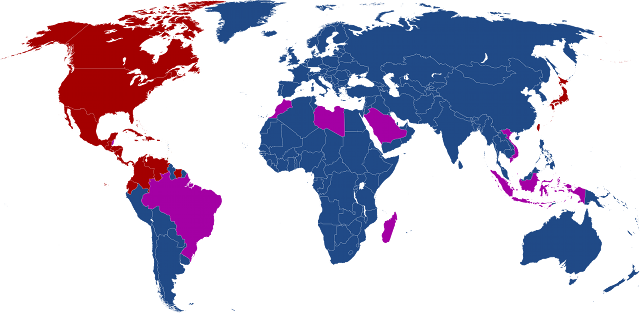I saw a tweet recently that intrigued me:
http://twitter.com/#!/yoz/status/191445005414567937
The voltage of mains electricity varies from country to country: the majority of countries use between 200 and 240 volts, but a small minority (most notably the US, Canada and Japan) use between 100 and 127 volts.

Countries using 100-127 volts are shown in red; countries using 200-240 volts are shown in blue. Countries with a mixture of the two systems are shown in purple.
The voltage* of an electrical supply is what pushes electrons around in a circuit. The higher the voltage, the faster the electrons move and thus the higher the current (one amp is equivalent to about six billion billion electrons flowing past a point per second). With a low voltage the rate of transfer of electrical energy is therefore much slower. In the UK, with a mains voltage of 230 V and a limit of 13 A per socket the maximum possible power to one appliance is 2990 watts (2990 joules per second). In the USA, with a mains voltage of 120 V and a limit of 15 A per outlet the maximum possible power is reduced to only 1800 watts, which is why in the US many large appliances (e.g. washing machines, tumble dryers) have to be connected to a separate high-voltage circuit.
To raise the temperature of one litre of water from 15°C to boiling at 100°C requires a little bit over 355 kilojoules of energy. An “average” kettle in the UK runs at about 2800 W and in the US at about 1500 W; if we assume that both kettles are 100% efficient† than a UK kettle supplying 2800 joules per second will take 127 seconds to boil and a US kettle supplying 1500 J/s will take 237 seconds, more than a minute and a half longer. This is such a problem that many households in the US still use an old-fashioned stove-top kettle.
* As a physicist I would normally use the term “potential difference” in place of “voltage” but voltage is better understood by the general public. Looks like the engineers (who prefer “voltage”) won that battle.
† As electric kettles actually use the joule heating effect that is responsible for most of the energy wasted in other electrical devices this isn’t a terribly unfair assumption.
I dont think that is entirely true, whilst power is transmitted at 110 V. The US has a split -phase power system, meaning it is easy to double the voltage and many circuit breakers do just that for high demand electrical equipment. American homes have energy intensive equipment such as tumble dryers (usually to a higher rating than europe), Air Cons, irons, coffee pots etc. The kettle is really just a case of demand.
Your science is impressive. But the conclusion falls apart somewhat when we consider that Americans will use a microwave oven or an electric stove to heat water in a mug or stove-top kettle, which surely faces the same problem of lower voltage, amps and watts… In the US it must take a similarly longer amount of time to heat an electric stove coil or a microwave, because of the lower voltage, unless the microwave or stove is connected to a special high-voltage circuit, so aren’t generally any faster at heating up, therefore are really no faster at boiling water than an electric kettle. Then there’s the extra time needed to heat the metal of the kettle! This sociologist’s view is that the reason for the different kettle use is largely cultural habit. To demonstrate the point, Japan uses a 100 volt system, lower than the US 127V. Yet, living in Japan means having an electric kettle. Every Japanese kitchen has one, for coffee, tea, or instant ramen. To quote one writer, “I’ve lived in Japan for quite a while and I’ve never seen a home without one.”
Nice try, David, but wrong. Stick to the sociology. UK microwaves don’t use as much power as is available, unlike UK kettles. You need to learn the difference between voltage, current and power. Maybe the Japanese are just more patient than those in the US, maybe they’re boiling smaller quantities of water, there are plenty of explanations that don’t require us to disregard the laws of physics.